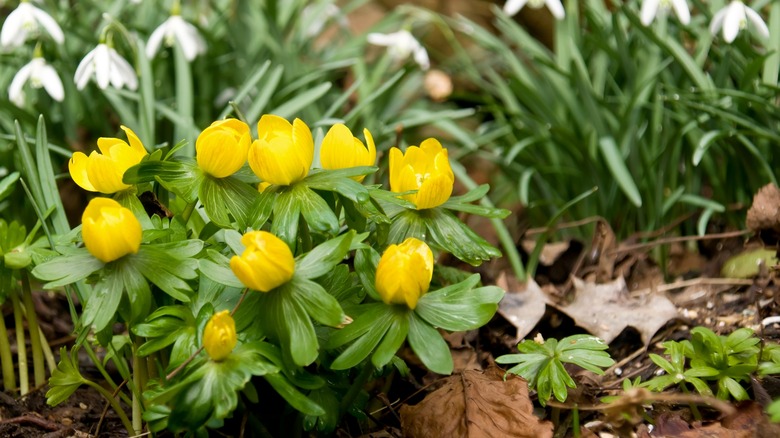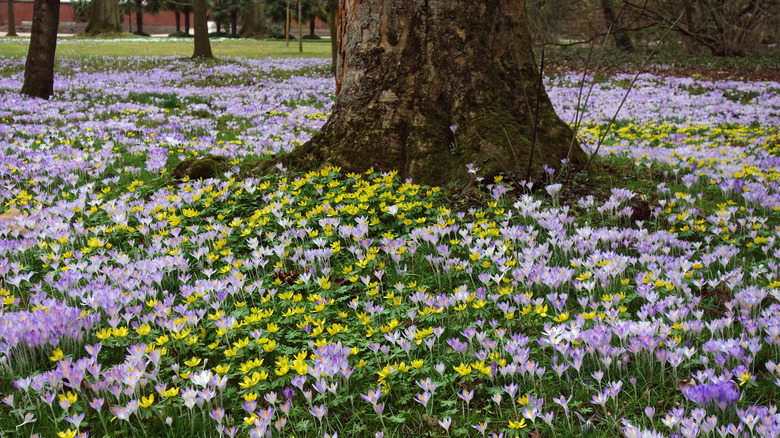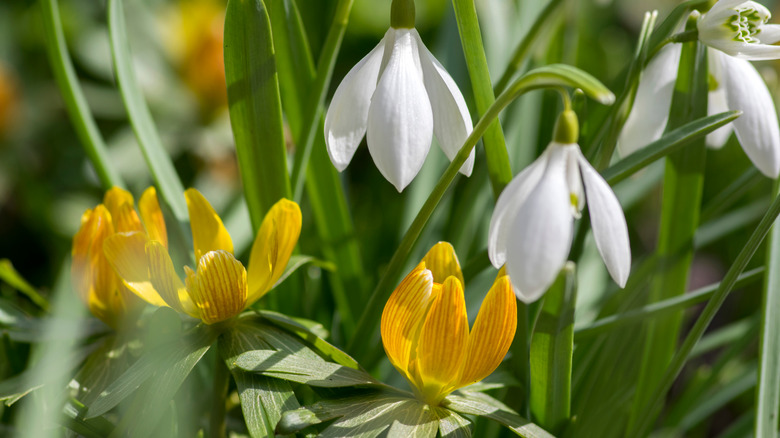Important Things To Consider Before Planting Winter Aconite In Your Garden
Heralding the arrival of spring with their vibrant yellow blooms, winter aconites (Eranthis hyemalis) are charming and resilient flowering plants. Winter aconites, also known as winter hellebore and winter wolf's bane, originated in Europe and Asia. These petite flowers often emerge in late winter or early spring, sometimes even poking through the snow, making them shine like a beacon of hope and color in the dreary winter landscape. Before you set out to plant your own winter aconite, consider factors like choosing the right location, getting them established, when to plant, care requirements, and — perhaps most crucially — the fact that they are poisonous.
What makes winter aconites particularly appealing to gardeners is their ability to thrive in challenging conditions. Their resilience to cold temperatures down to 5 degrees Fahrenheit makes them indispensable for gardeners in colder climates, spanning USDA zones 3 to 7. Winter aconites are among the first flowers to bloom after winter, providing much-needed sustenance for early pollinators like bees and butterflies who are unaffected by their toxicity. Their cheerful yellow flowers, resembling small cups, add a delightful pop of color to any garden bed, woodland area, or rock garden. They pair beautifully with other early spring bloomers like snowdrops and crocuses, creating a stunning tapestry of color in the garden.
Crucial considerations before planting winter aconite
Before you start cultivating winter aconites in earnest, there are specific considerations to ensure their successful establishment and growth. Winter aconites have delicate tubers prone to drying out if exposed for too long before planting. To mitigate this risk, procure fresh tubers from reputable suppliers and plant them promptly. If the tubers seem dehydrated, soak them for 24 hours in warm or room-temperature water before planting.
Winter aconites prefer well-drained soil with high organic content and an alkaline pH. Unlike some other flowering bulbs, winter aconites don't require extensive fertilization. In fact, excessive nitrogen can lead to lush foliage at the expense of flower production. Instead, opt for a balanced, slow-release fertilizer applied sparingly at planting time to provide a gentle nutrient boost without overwhelming the plants.
The winter aconites thrive in partial shade to full sun conditions, growing well underneath deciduous trees or shrubs where they can benefit from dappled sunlight. Aim to plant them in early autumn, allowing ample time for their roots to establish before the onset of winter. This timing also coincides with the natural dormancy period of the tubers, facilitating their acclimatization to the soil.
It's imperative to be aware of the toxic nature of winter aconites, as all parts of the plant are poisonous, containing alkaloids that can cause severe gastrointestinal distress and potentially cardiac arrest if ingested. Exercise caution when handling the plants, and refrain from planting them in areas accessible to curious pets or young children.
Caring for winter aconites
Once established, caring for winter aconites is relatively easy. During dry spells, provide supplemental watering to keep the soil consistently moist but not waterlogged to avoid root rot. Wear gloves when handling winter aconite plants, and keep them out of reach of children and pets. Under favorable conditions, winter aconites reproduce naturally and form expansive colonies, sometimes to the point of becoming invasive. To maintain control over their spread, remove clumps while they're still green. If you find that your winter aconites are naturalizing and spreading beyond their designated area, dividing the plants can help maintain order. Wait until after they've finished flowering, then gently dig them out of the soil and transplant them to their new location. Be mindful of where you've planted them, as their foliage dies back, making them easy to forget amidst the burgeoning growth of spring.
By considering these factors and following proper care guidelines, you can enjoy the cheerful beauty of winter aconites in your garden while ensuring a safe and thriving environment for plants, pets, and people alike.


